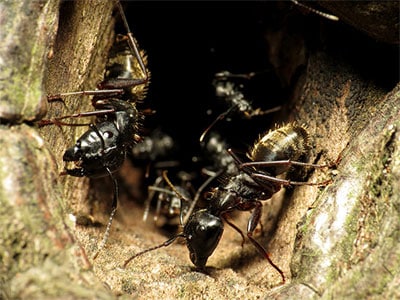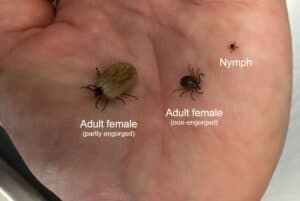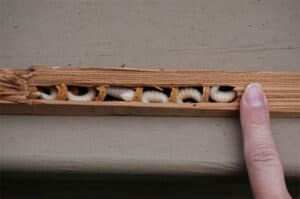Spring Pest Control
As the climate gets warmer year after year, many homeowners have seen increases in spring pests from one season to another. With this comes more potential for damage or infestations and the need to start the year off early by preventing spring pest invaders.
Homeowners Noticing More Spring Bugs Now Than Ever
This increase in population is happening for a few different reasons. One is that New York State isn’t experiencing the deep freeze that we were used to 10-20 years ago. Many pests burrow in the ground over winter, and the number of pests that make it through the winter is getting higher. Insects such as ticks, centipedes and millipedes would see significant decreases in the winter as the ground would frost deep. Then the surviving populations would start invading homes and landscapes once the weather warms in the spring. As we enjoy milder winters and early springs, these populations begin the season in higher numbers. Although many New Yorkers will associate snowfall with climate, the accurate indicator for pest populations is how long and deep the frost line goes or the number of days the temperature stays below freezing. According to the EPA, New York State sees more unfrozen days than ever.
5 Most Common Spring Pests In New York
#1 Carpenter Ants
These ants show up year to year in more significant numbers throughout Upstate New York. The populations are increasing, but we are seeing infestations in warming periods in January and February. Overwintering colonies will remain active but don’t forage as frequently. The queen will lay eggs continuously 12 months a year. This egg-laying creates an explosion of new ant hatching and activity in the first part of the year. To be prepared, many homeowners are taking action sooner. Homeowners should start exterior spring work sooner than ever, and having materials active inside the structure is highly recommended by Purdue Entomology and Cornell Cooperative. This means reducing exposure to moisture like checking gutters, downspouts and keeping water away from the roof and foundation. Homeowners can check all conducive areas every spring after winter for signs of carpenter ant damage as well as treat the exterior for the home for prevention.
#2 Ticks
Many field staff will argue that ticks are the number one spring pest issue. Tick pest control is by far the fastest-growing service year to year. You can attribute this directly to the change in the climate. Ticks generally burrow into the ground below the frost-line only to wake hungry for a blood meal the following year. With the decrease in the ground freeze, we have begun to see populations explode in the spring. Another reason is that many ticks live and feed on mice and rats. In #4 below you will see that they have been one of our top spring pests creating a symbiotic increase. Many homeowners are experiencing nymph ticks crawling all over them in the spring. One tick strikes so much fear because of their association with Lyme Disease. Here’s a quick guide to what ticks carry Lyme disease. Once ticks hatch from their eggs, they are ravenous for a blood meal. Also, adult ticks are hungry after a long winter waiting for a blood meal. Our tick treatments start in the early spring as soon as the weather breaks to shut down activity in high grass areas, woods, and ornamentals around the home. It’s crucial to repeat treatments on a four-week cycle through the spring to maintain the results and minimize populations.
#3 Mosquitoes
Everyone knows that mosquitoes love water, specifically standing water. New Yorkers are experiencing more significant rainfalls in shorter timeframes. This weather, combined with early spring, has caused more standing water and puddles around homes and businesses. Mosquitoes only need a short period to breed in standing water. Be on the lookout for planters, birdbaths and fixed puddling areas around the lawn with topsoil and oversees. Many homeowners are adding our Enviro 180 Yard Guard program to assist with mosquito pest control and tick extermination in one package around the home.
#4 Mice and Rats
Most folks think of rodents as merely winter not spring pests. We see more rodent populations outside year to year with the milder climate. Mice and rats typically breed in the insulation in the house, allowing them to forage outside and inside for food and water. Their ability to survive outside increases the amount of new entry into homes, sheds, and outbuildings. Be on the lookout for accessible access areas around your home. Check under garage door seals electrical and natural gas line entry points. Once they get inside your home, they will stay. Just because you don’t see them in the summer doesn’t mean they aren’t using your home for habitat. Spring should be for managing the landscape, eliminating ground cover, and being careful of overflowing bird feeders. Please don’t make it easy for rodents. Clear clutter in basements and inspect continuously to avoid infestations.
#5 Carpenter Bees
These menacing-looking furry flying pests made number five because they have been enjoying a more extended and more prevalent breeding season than we have seen in our 30 plus years as bee exterminators. Although Carpenter bees rarely sting, they did some significant damage to homes last spring. The early spring and warmer temperatures increased populations, and our service calls increased 400% just for carpenter bees. It would not surprise us with an early spring to have carpenter bees move to the top of our spring pests list. Once carpenter bees chew into the fascia or exterior wood trim on a home or barn, they will lay eggs, and then the larvae hatch, chewing their way out of the wood. Treatments should start in the spring to prevent the original chewing but always be maintained because eggs will likely continue to hatch later in the season. Our bee pest control packages include carpenter bees, including regular exterior maintenance.
Who To Choose For Your Spring Pests Coverage
Whether you have an issue with one or multiple pests this spring, take the time to find a company that can assist you in professional and safe pest control methods. Spring pests start earlier, meaning more damage to homes and exposure to diseases like Lyme disease. Your pest control company should do the same by starting earlier and creating an indoor and outdoor environment for your family to enjoy.




